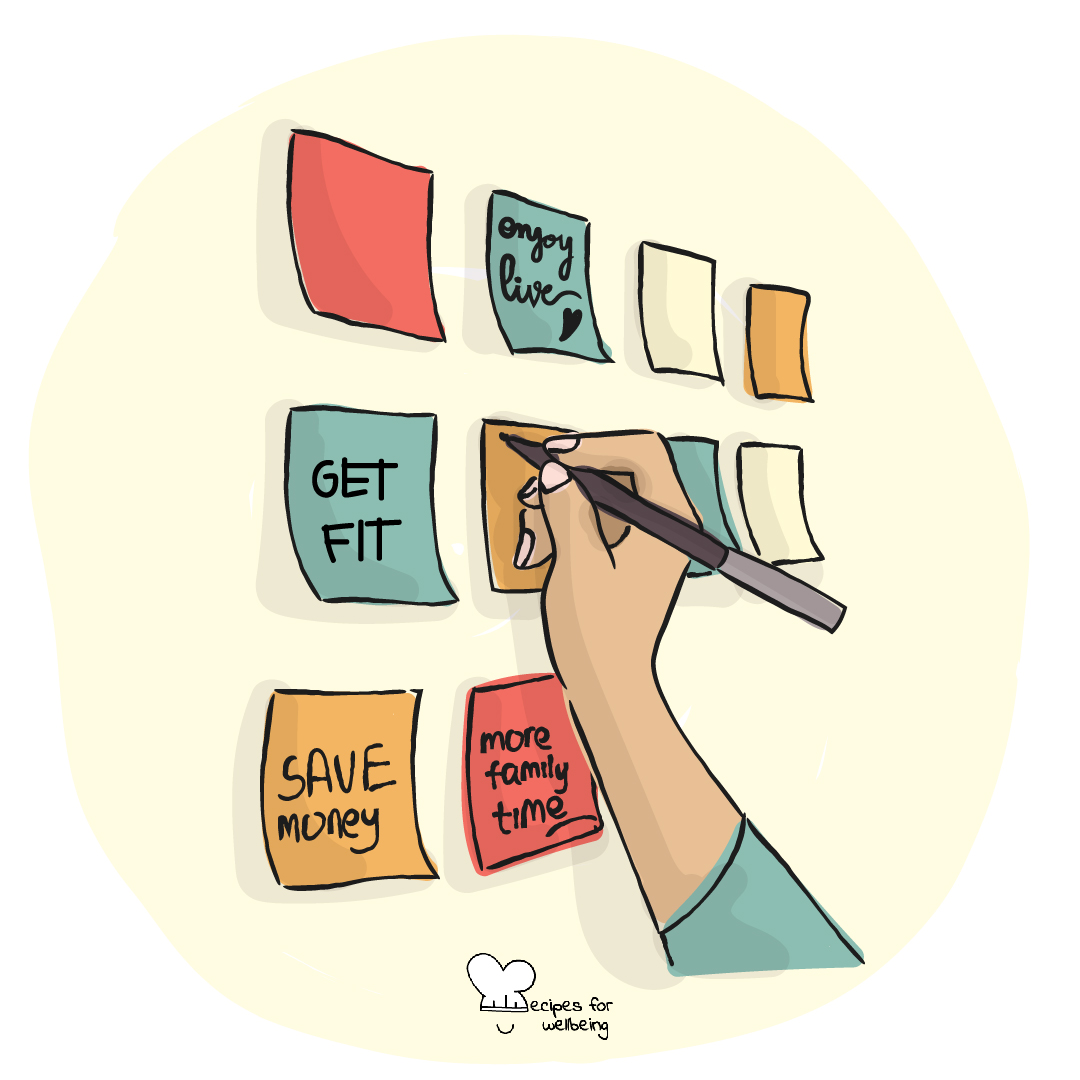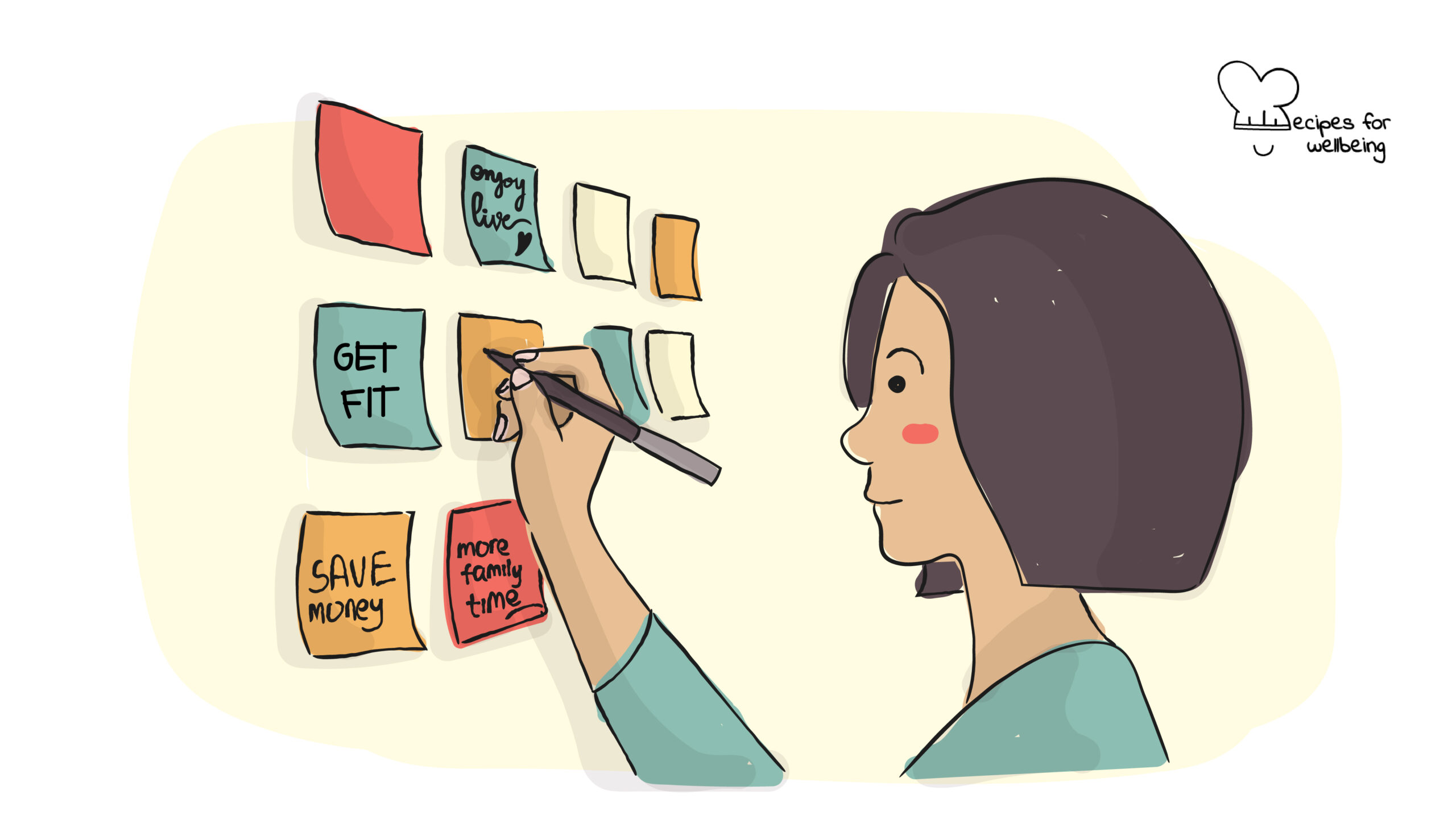
Backcasting to move forward
If you don’t know where you are going, any road will get you there. ―Lewis Carroll
👥 Serves: 1 person
🎚 Difficulty: Medium
⏳ Total time: 61-120 minutes
🥣 Ingredients: Journal (or sheets of paper), pens/coloured markers, 10 sticky notes
🤓 Wholebeing Domains: Accomplishments, Discomfortability, Meaning
💪 Wholebeing Skills: Adaptability, Agency, Agility, Commitment, Decision-making, Determination, Direction, Goal-setting, Planning

Backcasting to move forward
📝 Description
A backcasting practice to clarify your wellbeing goals and catch yourself when you are off track.
As you embark on your wellbeing journey, it is important to gain clarity about your goals (What values do I want to live my life with? How do I want people to remember me when I am gone?), to explore the strategies you can adopt to reach them (How can I embody my values in my everyday life? What practices can help me move towards my goals?), and to identify the most effective structures to catch yourself when you are off track (How will I feel when I am in alignment with my values and goals? What are warning signs that tell me I’m off track?).
The following recipe uses backcasting as a useful approach to anticipate the future. Our reality is partly a result of our past decisions and actions, meaning we play a role in co-creating the future we want. Backcasting helps you shift away from the tendency to spend too much time thinking about what life will be like when you arrive at the end goal you want – and instead, spend more time accurately assessing and planning how to get there.
As you think about your ideal future, it is also useful to reflect on how hard it might be to get there as you are inevitably going to face challenges and pitfalls. Visualising the worst-case scenario (What does the worst-case scenario look like? What are the potential causes and conditions?) can help you choose between different roads that present in front of you or build the emotional resilience to bounce off when things go South.
This activity has been gifted by our wellbeing content partner Nadya Saib of Wangsa Jelita and has been featured in their 2021 Well-being Journey Journal. It has been inspired by Nadya’s learning journey in Farnam Street’s online course Decision by Design and by Gabriele Oettingen and Doris Mayer’s article The motivating function of thinking about the future: Expectations versus fantasies (2012).
👣 Steps
Step 1 – Visualise the future (15’)
Imagine you are 90. Looking back at your life, what do you remember as the highlights? How do you want to be remembered? Think of the world after you leave, what do you wish to leave behind? What are your values? Take the time to ponder over these questions and use your journal to capture whatever comes to your mind.
Step 2 – Define your top 10 (10’)
Now create a list of your top 10 goals that you think are important in your life based on your experience during the visualisation. Write down the list in your journal.
Step 3 – Prioritise goals (15’)
Take 10 sticky notes or 10 small pieces of paper. Write one of your goals on each sticky note. Time for battle! Choose whichever goal you think is the most important to you, place it on a wall if it is a sticky note, or on a table if it is a piece of paper. Then grab another objective and place the sticky note next to the first one, so they are side by side. Compare the two by asking: “If I absolutely had to choose between only these two objectives, which one would matter more?” Repeat this process for all the sticky notes until you have prioritised your goals from most important to least important. When you are done, write down your prioritised list of goals in your journal (along with their quantity, if any).
Tip: When doing this step, you might look at a pair of goals and think that you do not necessarily have to choose between them. If that’s the case, make them battle anyway. Maybe in real life you can, but if you cannot, at least you know which one matters more. Also, it might help to “quantify” the objectives as you battle them. For instance, let’s say that you wrote that spending time with your kids is important, but also that making a living is important. When you battle them, quantifying each goal might give you more clarity, e.g. spending X hours/day with my kids or earning X money/month.
Step 4 – Inviting a conversation (20’)
Invite your spouse, partner, or safe person to have a conversation about the most important thing that matters to you. Invite them to reflect on and share theirs too. Understanding what is most important to each other is valuable information to support one another.
Step 5 – Imagine the ideal future (10’)
Take your journal and write down what your ideal future is. Imagine yourself in that ideal future and elaborate on what it is like. What makes it ideal? What does your life look like? Describe a day in that future in as much detail as you can.
Step 6 – Backcasting (10’)
Once you have a clear picture in mind, start working backwards. What did you do to arrive there? What behaviours, decisions, and actions did you have to take to get to where you are now (in your ideal future)? Write in the past: “To get success, I DID…” instead of “I have to do…”. Focus on what you DID do. The difference is subtle, but it changes responses from things that are often outside of your control or ambiguous to something you have more control over.
Step 7 – Keep on track (10’)
Now that you have your path, come back to the present moment and reflect: What are the signs you are on the right track? How about the signs when you are three-quarters of the way there? What are the signs that you are halfway to your target? What are the signs in the near future that you are headed in the right direction? What will you have done, or not done, to keep on track in the best-case scenario?
Step 8 – Imagine the worst-case scenario (10’)
Now, instead of your ideal future, imagine you have arrived at your worst-case scenario. What does life look like? Describe a day in that scenario in as much detail as you can.
Step 9 – Backcasting (10’)
Repeat step 6 – start working backward. What did you do to arrive at this worst-case scenario? What behaviours, decisions, and actions did you take to get to where you are now?
Step 10 – Keep on track (10’)
Come back to the present moment and reflect: What are the signs that you are on the wrong track? What are the signs in the near future that you are headed down the wrong path? What will you have done, or not done, that means you are on track for the worst-case scenario?
Step 11 – Integrate
Integrate the learnings from these explorations of the best- and worst-case scenarios in the decisions and actions you need to make and take to reach your goals.

